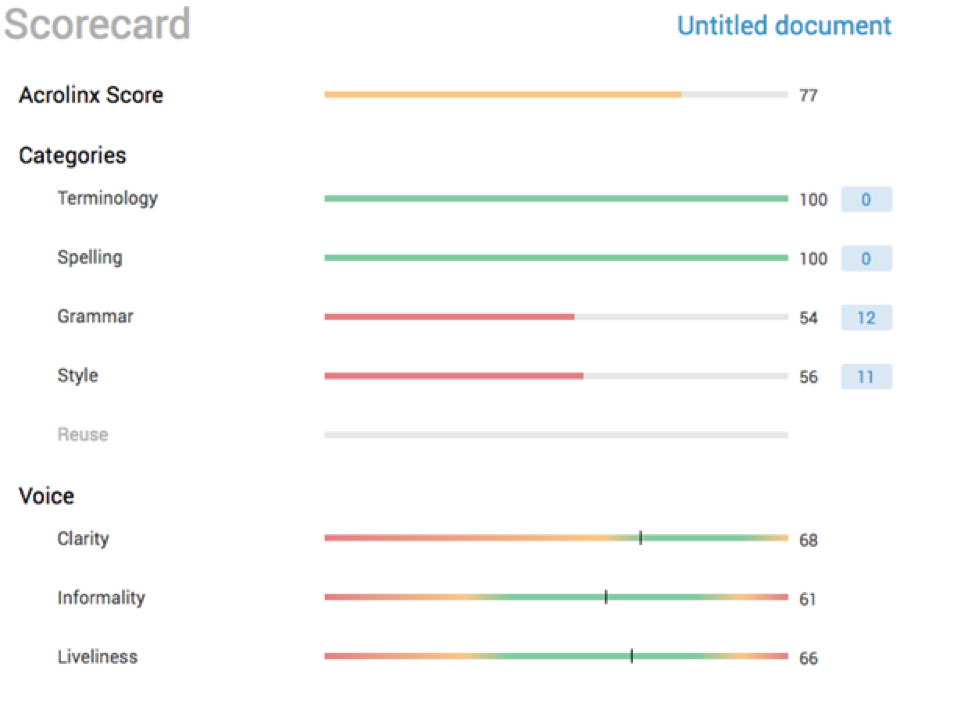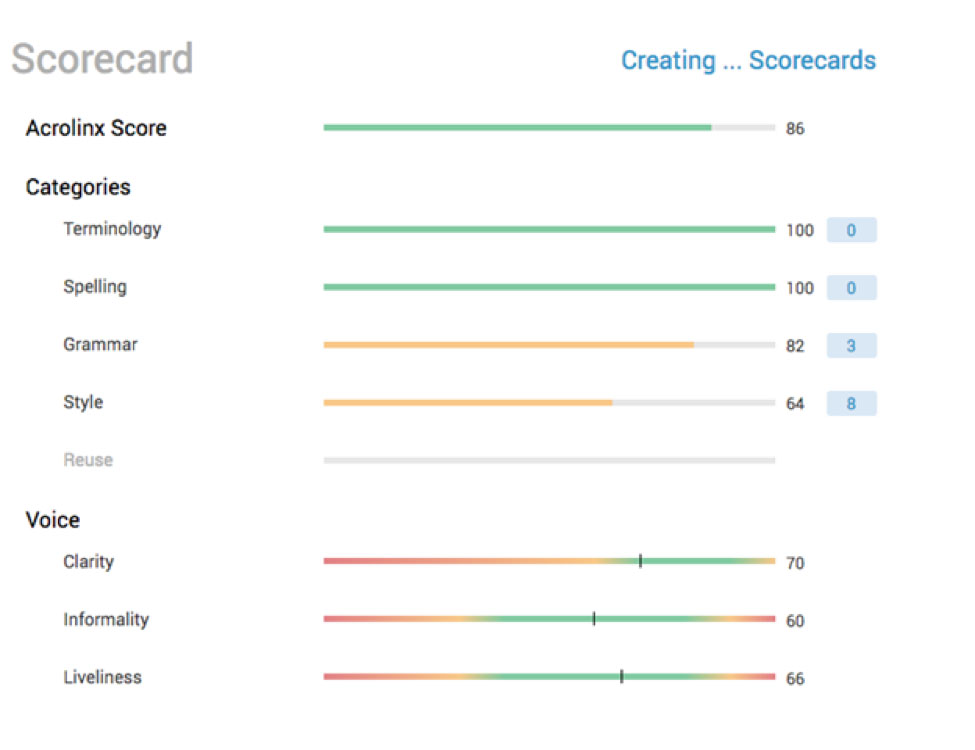Content: It’s everywhere. And, managing it is getting out of hand. Content is difficult to manage because, until recently, it was seldom thought of as a business asset worthy of measurement. But that’s quickly changing.
Measuring takes the guesswork out of business. Collecting metrics allows companies to focus their efforts on quantifiable factors (key performance indicators) that are directly linked to achievable business goals.
Measurement allows us to know whether the time, effort, and money we invest in what we do is worth it. Metrics provide us with actionable data on which we can make informed business decisions.
To create high-quality content, we must measure our content against a formal set of quality criteria. And, in order to scale content production, we must automate as much of the measurement process as possible. By leveraging the power of computers and artificial intelligence, we can do that today.
The Need for a Content-Quality Performance Scorecard
The words we choose to use have a tremendous impact on others. We know this instinctively. The right words can inform, instruct, and inspire. The wrong ones can confuse, confound, and contradict.
Content conveys the personality of your brand. It often represents the first impression of your company. It projects your values and sets expectations for both prospects and customers alike.
Producing high-quality content is critical to business success. Quality content follows rules (sentence structure, spelling, punctuation, and grammar). It is also easy to read and understand. High-quality content is consistent in style and structure, and in tone of voice.
Writers and editors have traditionally been responsible for ensuring the right words are used — and the wrong ones are not. They work to make certain that your content is of high quality. But, despite their best efforts, writers and editors are error-prone. Not only that, they are not scalable.
Armed with style guides, desktop dictionaries, and thesauri, writers attempt to craft high-quality content that complies with a lengthy checklist of rules they must first study, learn, and use. When they make a mistake, an editor is expected to catch the error. But that’s not always what happens.
Editors are often overburdened and are just as likely to make mistakes as their writers. Most editors rely on outdated mechanical (manual) editing processes to catch an increasing array of content problems, many of which may introduce unnecessary legal, regulatory, and financial risks.
Performance scorecards provide us with a set of rules against which to measure content quality.
What Are Performance Scorecards, Exactly?
Performance scorecards are management tools designed to help us monitor our progress over time toward an organizational goal. Scorecards contain targets (goals we strive to achieve) and key performance indicators (measurements that tell us whether we are reaching our goals or not).
Well-designed performance scorecards use commonly understood visual metaphors to allow us to quickly determine whether we are on the right track or not. The data they present are the visual answer to the question: “How well are we doing?”
Performance scorecards are in use across all industry sectors and vertical markets. They are most effective when they are designed to capture outcomes (how well we did) and when we build rewards into the system.
As leadership guru John E. Jones once said: “What gets measured gets done. What gets measured and fed back gets done well. What gets rewarded gets repeated.”
Producing High-Quality Content: Why Performance Scorecards Matter
Performance scorecards provide insights into our strengths and weaknesses. They help us see opportunity for improvement, provide us with a way to prioritize our efforts, and ensure that we are meeting business goals. But collecting performance data manually is slow, inconsistent, and error-prone.
Performance measurements are most valuable when integrated into software tools we use to create content. By automatically capturing relevant measurements and providing real-time feedback to content creators, we can reduce the amount of work required to produce high-quality content. Faster time-to-market, increased consistency, and reduced costs are some of the many benefits of such an approach.
Producing High-Quality Content: Why Performance Scorecards Fail
Scorecards are not magical. They don’t do anything by themselves. Their value is heavily dependent on how they are executed.
The biggest reasons why performance scorecards fail is disagreement over what data to measure, how to measure and collect it, and what the resulting findings mean. To be successful, scorecard data must be defined in the same way by everyone using it. All parties involved must agree on a common definition of the data being collected. Data should be uniformly measured and specific actions taken as a result of the findings.
There are other reasons scorecards fail. One of the most important to recognize is that some people don’t like the idea of being monitored. There are many reasons why people dislike being monitored.
First, measuring means paying attention to details. Not everyone wants that level of scrutiny paid to their work.
Second, some people see performance monitoring as a way to measure their personal performance. Scorecards are used most often to ensure business outcomes, not to monitor people. To ensure that performance scorecards provide the most value to the organization, it’s important to communicate what is actually being measured.
For example, the marketing communication team at Illumina, a Silicon Valley medical device manufacturer, uses a content scorecard system to determine what content performs the best. Writers use Acrolinx software to score the content they create in real time. The software measures adherence to standard linguistic, grammar, spelling, and punctuation rules. It also provides readability scores and allows the company to encode its writing, style, branding, and corporate terminology rules into the authoring process.
Before publication, each piece of content is scored. Scores for each piece of content produced are stored as metadata in the company’s content management system. The marketing team combines content quality scores from Acrolinx with typical web content metrics (number of visitors, length of visit, and on-site behavior, including number of actions completed). They do this to show that content quality metrics do matter. Illumina has found that content that meets quality standards often outperforms content produced without the benefit of automated, real-time scoring.
Seeing It in Action: Scoring This Article
I wrote the first draft of this article without the help of content scoring software. Once I was happy with it, I sent it to an editor. Then, we ran the edited draft through Acrolinx. The draft scored fairly well (77 out of 100), but there were grammar and style violations. And, it wasn’t written as clearly as it could have been.

But, with just a few changes recommended by Acrolinx, I was able to make improvements that raised my overall Acrolinx Score. And, I spotted some errors that emerged during the writing and editing process.

Using a scorecard approach makes producing quality content the focus of our work, not micromanaging writers and editors. Acrolinx is designed to guide content creators toward the creation of quality content. Content that complies with an agreed-upon set of rules. Content that follows an agreed-upon style. Content that meets customer expectations and helps us achieve business goals.
To create high-quality content at scale, we can’t rely on human editors alone. Instead, we must leverage the power of software to help us. We must automate the measurement process as much as possible. By leveraging the power of Acrolinx, we can do that today.



